A little-remembered magazine interview from 1987 may hold clues about what Trump and Putin are ultimately up to. What was on Trump’s mind back then — besides dispensing unsolicited foreign policy advice in full page newspaper ads? Nothing less than making a deal with the Soviets to jointly seize the world’s nuclear weapons and thus bring about world peace.
He told writer Ron Rosenbaum in an interview for the magazine Manhattan, inc., “We approach [the USSR] on this basis: We both recognize the nonproliferation treaty’s not working, that half a dozen countries are on the brink of getting a bomb. Which can only cause trouble for the two of us. The deterrence of mutual assured destruction that prevents the United States and the USSR from nuking each other won’t work on the level of an India-Pakistan nuclear exchange. Or a madman dictator with a briefcase-bomb team. The only answer is for the Big Two to make a deal now to step in and prevent the next generation of nations about to go nuclear from doing so. By whatever means necessary.”
I’ve come to believe this interview, largely forgotten (save for being republished with a new foreword by Slate in 2016) is a missing fossil in the record that explains much of what we are observing today. Let me elaborate further.
Nuclear Scientists and the USSR
After the first nuclear weapons were deployed in Japan in 1945, many of the scientists who helped develop them were shocked and felt deep moral outrage that the United States had killed civilians. In particular, and primarily so that Hitler would not get there first, the Jewish scientists Leo Szilard and Albert Einstein had proposed the bomb project to President Roosevelt. They formed the kernel of a network of like minded scientists who came together under the umbrella of the Federation of American Scientists.
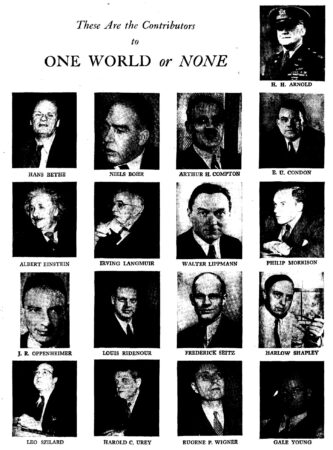
Contributors to “One World or None,” 1946. (FAS)
In 1946, they published an influential tract titled “One World or None,” which argued that nuclear weapons must be brought under the control of a global authority; otherwise they felt that proliferation would become inevitable, and as proliferation continued, a fatal deployment or escalation would become inevitable. They argued that the planet must come together as “one,” or we would risk losing it (“none.”)
Bernard Baruch, a Manhattan financier, drafted a proposal (known as the Baruch Plan) that would have the United States decommission all of its nuclear weapons on the condition that other countries would do the same. The Soviets, fearing it would excessively curtail their sovereignty, strongly opposed Baruch’s plan.
Instead, the Soviets aligned themselves with a wide array of groups that attracted prominent American scientists like Harlow Shapley from the Harvard Observatory, and organizations like the Independent Citizens Committee of the Arts, Sciences and Professions.
These groups reflected alignment with the KGB and the Communist Party USA in that they sought to undermine American nuclear capacity while also arguing for technology transfer to the Soviets in a bid, they maintained, to level the playing field and minimize risk of conflict.
Their efforts led to the nomination of Henry Agard Wallace (Franklin Roosevelt’s agriculture secretary) to run for president in 1948 under the banner of the Progressive Party. Wallace’s platform? Putting an end to what he argued was rampant American expansionism, and promoting rapprochement with Russia — both in the name of global peace.
The Influence of Uncle John
In the Rosenbaum interview, Trump emphasizes that it was through his many discussions about “nuclear” with his uncle, MIT scientist John G. Trump, that he formed his opinions about global nuclear disarmament.
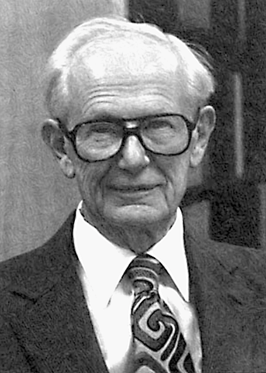
John G. Trump in 1979. Wikipedia
Quoting the interview: “[Uncle John] told me something a few years ago. He told me, ‘You don’t realize how simple nuclear technology is becoming.’ That’s scary. He said it used to be that only a few brains in the world understood it and now you have a situation where thousands and thousands of brains can easily understand it, and it’s becoming easier, and someday it’ll be like making a bomb in the basement of your house. And that’s a very frightening statement coming from a man who’s totally versed in it.””
Such a claim, which is not unreasonable, would have fit right into One World or None.
John Trump also had direct ties to Soviet activities in America. Nikola Tesla, the famed electrical engineer who died broke in the New Yorker Hotel in 1943, had allegedly developed an electrical “death ray” super-weapon. The Soviets were keenly interested in this rumored technology, and arranged to purchase Tesla’s personal papers through an organization called AMTORG, a KGB front operating in New York originally formed by Russian-American industrialist Armand Hammer.
John Trump was the person selected by the US government to review Tesla’s papers for any US national security concerns before they were transferred to the Soviets. He would have been broadly aware of the Soviet worldview regarding the fields of defense and energy, as well as those prominent amongst his fellow scientists at the time — which were also shaped by Soviet influence.
And given that the USSR was an American ally during World War II, this was not uncommon or even seen as especially objectionable — at least until the second red scare ramped up in 1947.
The Art of the Deal
By 1987, according to extensive reporting by writers such as Luke Harding and Craig Unger, the younger Trump had formed a working relationship with the Soviets.
Questions remain as to whether Ivana Trump collaborated with the Czech StB (a branch of the KGB) to arrange for a “fortuitous relationship” with Trump, for purposes of projecting power through him into business and politics. Nonetheless, Trump enthusiastically dove into foreign policy discussions in 1987 and started talking about running for president.
He told Rosenbaum that he would bring peace to the world by making a deal it couldn’t refuse. He would use economic power to disarm the French, and of Pakistan he quipped, “I guess the easy thing would be to say you go in and clean it out,” speaking of that country’s emergent nuclear capabilities.
He saw Reagan’s arms negotiations as effete, and led by buffoons who lacked the talent to strike a complex business deal. Claiming to have read Strobe Talbott’s dense and detailed book Deadly Gambits which drones on about the various rounds of START talks and the people behind them, Trump did what he does best: oversimplify the situation into a reductive “deal” framework that he feels he is uniquely capable of not only understanding, but executing.
Where Bernard Baruch and Paul Nitze had failed, Donald Trump believed he could prevail — with a little help from his Russian friends.
The Putin-Trump Bid for World Peace
Since 1987, the USSR has perished, while the KGB survived as the FSB and in the person of Putin himself. And Donald Trump is the presumptive GOP 2024 nominee for President. Both men are keenly concerned with their legacy and seem intent on being remembered as world historic figures.
Given Trump’s history with Putin, there is scant evidence to suggest that Trump’s ideas from 1987 — those transmitted to him from the late 1940’s by his Uncle John — have changed substantially.
Trump appears to believe the world can be disarmed at gunpoint — with Putin’s nukes as the ultimate backstop to the threat. Trump has repeatedly demonstrated he is willing to undermine the security of the United States. We still don’t know the damage done by the potential leak of nuclear secrets haphazardly stashed in a spare bathroom at Mar-a-Lago, available for inspection by any of the thousands of passers-through. And he’s been pulling strings in Congress (only partially successfully) to ensure that aid will not flow to Ukraine, or at least be delayed or diminished.
Trump appears to believe that Putin is righteous in his quest to reorient the world away from American hegemony, and he seems to be willing to subordinate America’s sovereignty to realize that goal.
These two men appear poised to try to effect a final disarmament — rooted in fear. And we should expect Aleksandr Dugin, David Sacks, Elon Musk, and Glenn Greenwald to be applauding enthusiastically as they are considered for the Nobel Peace Prize. And we heard it first from Ron Rosenbaum, in 1987. Would that we have heeded Trump’s words then.
Given events unfolding in the Middle East and Ukraine, our geopolitical trajectory is one of continuous escalation. Talk of nuclear annihilation is everywhere. However events play out, it seems likely that we will be facing several years of nuclear blackmail waged against anyone who dares to oppose the Putin-Trump axis, claiming as it does to be acting in the name of achieving world peace.
Dave Troy is an investigative journalist focused on exposing threats to democracy. Based in Baltimore, his background as a technologist with an interest in studying online extremism affords him a unique perspective. His work has appeared at MoMA in New York, and he is a fellow with New America Foundation’s Future Frontlines. Dave writes regularly about information warfare, history, and politics. He is the host of the podcast Dave Troy Presents, and speaks regularly at conferences on disinformation, extremism, and information warfare. Contact information is available at davetroy.com.

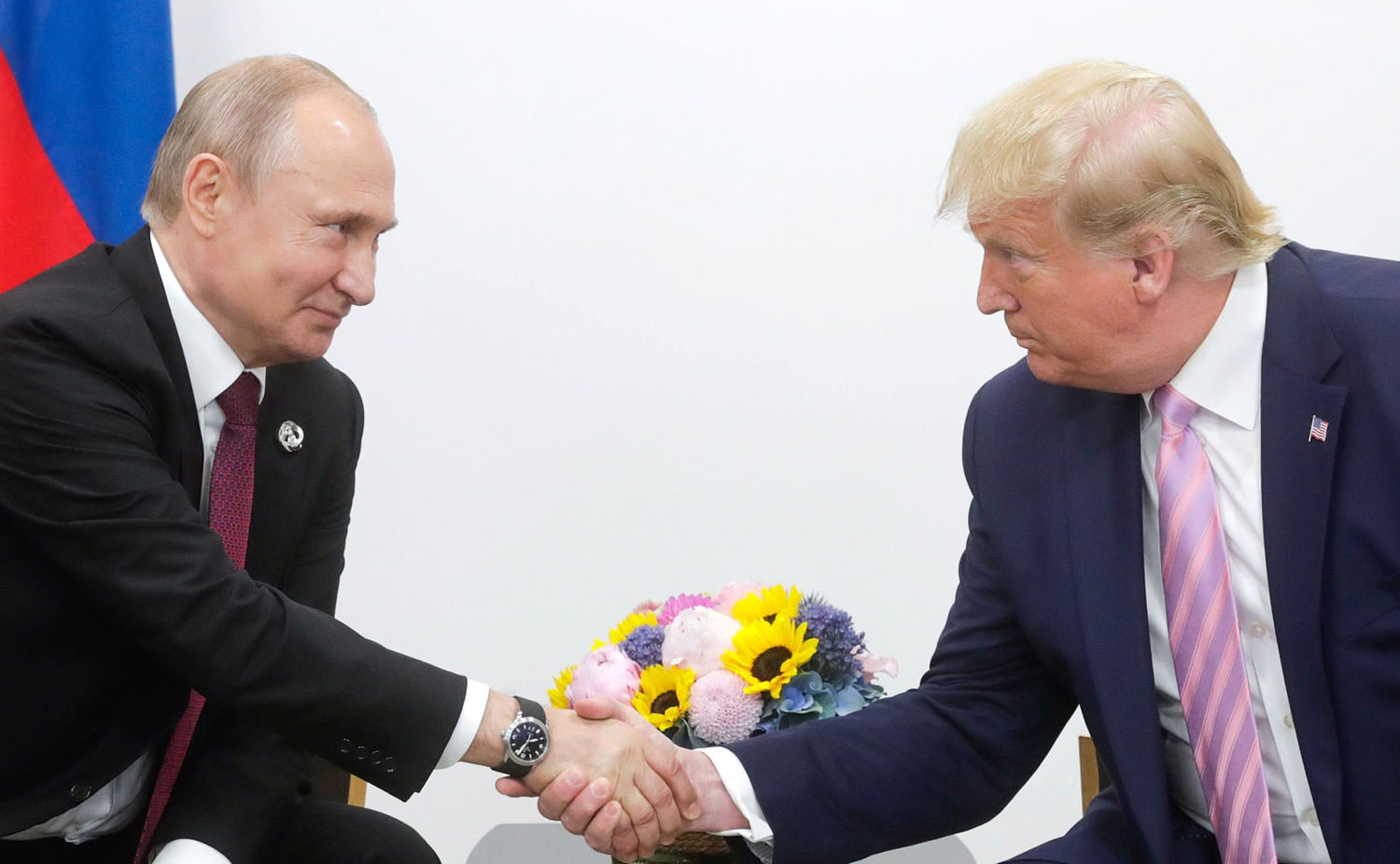
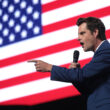
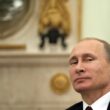
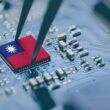
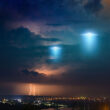

0 Comments